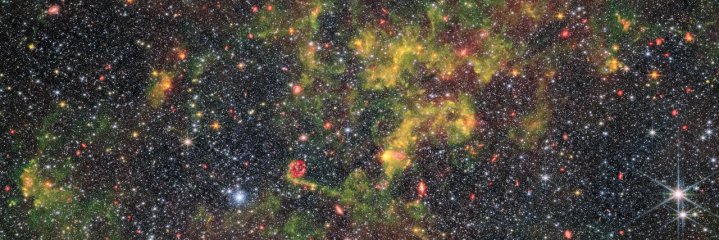A series of new images from the James Webb Space Telescope shows the dusty, irregular galaxy NGC 6822 — and the different views captured by various Webb instruments.
Located relatively close by at 1.5 million light-years from Earth, this galaxy is notable for its low metallicity. Confusingly, when astronomers say metallicity they do not mean the amount of metals present in a galaxy, but rather the amount of all heavy elements — i.e., everything which isn’t hydrogen or helium. This factor is important because the very earliest galaxies in the universe were made up almost entirely of hydrogen and helium, meaning they had low metallicity, and the heavier elements were created over time in the heart of stars and were then distributed through the universe when some of those stars went supernova.

This image from Webb combines data from two of its instruments, the Near-InfraRed Camera (NIRCam) and the Mid-InfraRed Instrument (MIRI), to show off features like the clouds of dust (shown in yellow) and areas of active star formation (seen in red).
To understand how scientists build up images like this out of different observations, Webb researchers also released the individual views taken by NIRCam and MIRI. Because the two instruments look in different parts of the spectrum — NIRCam in the near-infrared and MIRI in the mid-infrared — they can pick out different features. When the two views are combined, they show even more detail than one view could alone.

This is the MIRI image, which highlights regions of dust that are more noticeable in the mid-infrared. The cooler areas of dust are in blue, while warmer dust clouds are seen in orange. And the different colors can help pick out different galaxies too, with nearby galaxies appearing green and more distant galaxies seen in orange. There is even a bright orange ring shape near the center bottom which is the remnant of a supernova.

This is the NIRCam image, which picks out the thousands of stars visible to Webb which are hard to see in the MIRI image. In this wavelength, NIRCam can peer through the dust and see the stars which would otherwise be hidden, with the brightest stars glowing in blue and fainter stars in red.
If you’d like to see a slider comparison of the MIRI and NIRCam images, that is also available on the Webb website.
Editors’ Recommendations
James Webb image shows the majesty of the most massive known galaxy cluster
Webb spots water vapor in a planet-forming disk
See the stunning image James Webb took to celebrate its first birthday
One galaxy, two views: see a comparison of images from Hubble and Webb
James Webb spots the most distant active supermassive black hole ever discovered

Georgina is the Digital Trends space writer, covering human space exploration, planetary science, and cosmology. She…
Saturn as you’ve never seen it before, captured by Webb telescope

NASA has shared a gorgeous image of Saturn captured recently by the James Webb Space Telescope (JWST).
Webb’s first near-infrared observations of the second largest planet in our solar system also show several of Saturn’s moons: Dione, Enceladus, and Tethys.
Read more
James Webb spots clues to the large-scale structure of the universe

If you look at the universe on a big enough scale, the billions of galaxies out there aren’t randomly scattered. Instead, they form a structure made up of galaxies and the gas between them, which are connected into filaments in a geometric-like pattern. This structure is known as the cosmic web, and it was created by the conditions at the start of the observable universe during the Big Bang.
The James Webb Space Telescope recently spotted some of the earliest evidence of this web, identifying some extremely old galaxies which were observed just 830 million years after the Big Bang and which are formed into a filament.
Read more
James Webb detects important molecule in the stunning Orion nebula

The Orion Nebula is famous for its beauty, but it was also the site of a recent exciting scientific discovery. The James Webb Space Telescope has detected an important molecule in a planet-forming disk of debris within the nebula. The molecule, called methyl cation (CH3+), is a carbon compound that is important for the formation of life and has never been observed in space before.
This image is NIRCam’s view of the Orion Bar region studied by the team of astronomers. Bathed in harsh ultraviolet light from the stars of the Trapezium Cluster, it is an area of intense activity, with star formation and active astrochemistry. This made it a perfect place to study the exact impact that ultraviolet radiation has on the molecular makeup of the discs of gas and dust that surround new stars. ESA/Webb, NASA, CSA, M. Zamani (ESA/Webb), the PDRs4All ERS Team
Read more
>>> Read full article>>>
Copyright for syndicated content belongs to the linked Source : Digital Trends – https://www.digitaltrends.com/space/james-webb-ngc-6822/










